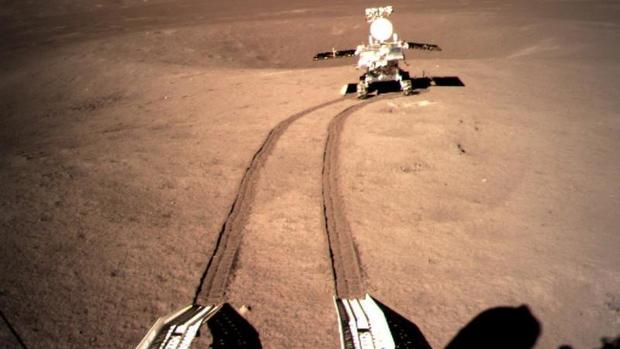 This handout image taken on Jan 3, 2019 shows China's lunar rover, Yutu-2, or Jade Rabbit-2, leaving the first ever "footprint" after rolling down a track extending from China's robotic lunar probe Chang'e-4 lander on the far side of the moon. (PHOTO / IC)
This handout image taken on Jan 3, 2019 shows China's lunar rover, Yutu-2, or Jade Rabbit-2, leaving the first ever "footprint" after rolling down a track extending from China's robotic lunar probe Chang'e-4 lander on the far side of the moon. (PHOTO / IC)
BEIJING - China's lunar rover Yutu-2, or Jade Rabbit-2, has driven 447.68 meters on the far side of the moon to conduct scientific exploration of the virgin territory.
Yutu-2 has worked much longer than its three-month design life, becoming the longest-working lunar rover on the moon
Both the lander and the rover of the Chang'e-4 probe have ended their work for the 17th lunar day, and switched to dormant mode for the lunar night due to the lack of solar power, according to the Lunar Exploration and Space Program Center of the China National Space Administration.
China's Chang'e-4 probe, launched on Dec 8, 2018, made the first-ever soft landing on the Von Karman Crater in the South Pole-Aitken Basin on the far side of the moon on Jan 3, 2019.
ALSO READ: China's lunar rover sets record for longest operation
As a result of the tidal locking effect, the moon's revolution cycle is the same as its rotation cycle, and the same side always faces the earth. A lunar day equals 14 days on Earth, and a lunar night is the same length.
During the 17th lunar day, Yutu-2 continued its exploration to the northwest of the probe's landing site and obtained a new batch of scientific detection data.
Yutu-2 has worked much longer than its three-month design life, becoming the longest-working lunar rover on the moon.
The rover has helped scientists unveil the secrets buried deep under the surface on the far side of the moon, enriching man's understanding about the history of celestial collisions and volcanic activities and shedding new light on the geological evolution on the moon.
READ MORE: Chinese lunar rover's 'lucky' find could unlock secrets
The scientific tasks of the Chang'e-4 mission include conducting low-frequency radio astronomical observations, surveying the terrain and landforms, detecting the mineral composition and shallow lunar surface structure and measuring neutron radiation and neutral atoms.
The Chang'e-4 mission embodies China's hope to combine wisdom in space exploration with four payloads developed by the Netherlands, Germany, Sweden and Saudi Arabia.
China plans to launch its first Mars probe and the Chang'e-5 probe to bring lunar samples back to Earth later this year.


